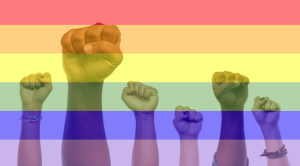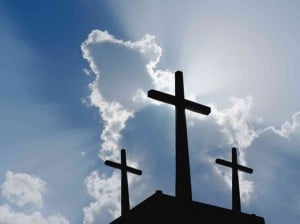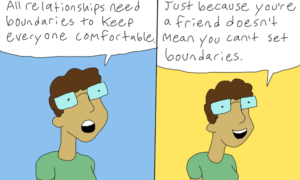The non-profit sector has a diversity problem. And that problem shapes our social movements.
When it comes to the fight for social justice, non-profit organizations play a special role in advancing progressive causes. They come with built-in funding and networks. They have the ability to amplify messages and ideas quickly to the right audiences. They shift – and sometimes directly impact – policy agendas.
But the people with those networks and that funding, the people who amplify those messages and ideas, and the people shaping policy agendas are mostly cis, straight, white men.
And that means the people running large social justice organizations – and, to some extent, the people staffing them – aren’t always willing or best able to build intersectional movements, serve the most marginalized folks in their community, or fight from the bottom up for social change.
The non-profit movement needs to live and breathe its values, and that means it needs more diverse leaders and movers and shakers to be within its ranks. And until they are, the fight for social justice will be lopsided and broken.
Here’s why.
1. Because Social Justice Leaders Should Look Like Their Movements
Here’s what we know about the non-profit sector, at a glance:
95% of philanthropic organizations are run by white people
Only 7% of non-profit CEOs and Executive Directors are people of color, and only 8% of non-profit board members are people of color
Women are CEOs of only 21% of large non-profits – and they only make 66% what their male counterparts make, on average
57% of internships at non-profit organizations are unpaid, pushing folks who can’t afford to donate free labor out of career tracks in the sector
Across the board, organizational leaders have often forgone mentoring and educating younger folks in the movement, creating not only a leadership gap, but an immediate crisis of movement leadership in the coming few years
Now, this isn’t what the entire non-profit sector looks like. Actually, most staff members at non-profit organizations are women, and though people of color and LGBTQIA+ people still don’t make up a majority of the sector overall, they are better represented as you look down the leadership ladder.
But leadership matters – and in a major way.
We know that diversity is important. We know that feminist leadership is about putting feminist values into practice. And that’s why we know that these statistics are unacceptable.
Until women lead environmental justice organizations, the urgent and ever-present interconnectedness of women’s issues with environmental issues will most likely fall to the wayside.
Until LGBTQIA+ folks are driving movements for economic justice, those movements will most likely fail to acknowledge the unique impact sexuality and gender identity have on our ability to survive financially.
And until people of color are crafting strategies to advance labor rights across the country, advocates for workers’ rights will miss out on opportunities to advance policies that uniquely impact folks of color in myriad workplaces.
Movement leaders should reflect the diversity of their movements, let alone the staff they’re leading.
They should be intimately aware with the ways our identities intersect and how those intersections shape our places in our movements.
And although it is possible for allies to consider the struggles of the most marginalized and do their best to shape movements around them, the ultimate form of empowerment is for those marginalized folks to be at the helm of movements themselves.
2. Because a Movement’s Agenda Matters – And Needs to Be Centered on the Most Marginalized
Having a seat at the table is different than simply being a part of someone else’s vision.
And steering the direction of a non-profit organization is something that should be done by the people most impacted by social justice movements – and people who belong to communities that need them the most.
Diversity in the non-profit sector isn’t just an image issue. It’s not about putting together a team that looks like they come from different backgrounds and lived experiences. It’s about power, and it’s about whom organizations tailor their work toward.
Non-profit organizations control millions of dollars. In 2014 alone, the sector held 5.3% of the national GDP.
And the people who control this money are the people who make decisions about what kind of organizing it will fuel, which audiences it will cater to, and which campaigns and movements it will make most visible.
Right now, most of those people are cis, straight, white men.
I’m not saying those men can’t be awesome, inclusive, and critical leaders. But when the people controlling the finances – and thus, the agendas – of the non-profit sector are among the least marginalized folks in those offices, it means that inevitably the work they do will fail to address some of the less prominent, but often more urgent, needs in their communities.
For the LGBTQIA+ rights movement, this kind of organizational failure is evident as the fight for marriage equality was won amid one of the most deadly years for trans women of color in recent history.
For trans folks and queer people of color, the issues that matter most to them – issues of homelessness, hate crimes, and survival – have been ignored at-large by the mainstream LGBTQIA+ movement that claims to represent their experiences.
In the racial justice movement, male leaders have often failed to address the ways issues like police brutality and reproductive rights shape women’s lives in their communities.
Black women have had to push the #BlackLivesMatter movement to march for women who are victims of police violence, and all too often, dialogue about gender in communities of color is lacking.
And in the feminist movement, leaders – many of whom are women, but are also often white women – have been (rightfully) criticized for catering to the needs of straight, white, middle-class women.
Patricia Arquette ignored intersectionality when she called for equal pay at the Oscars. Celebrities like Taylor Swift, Lena Dunham, and Miley Cyrus have been called out for practicing “white feminism.” And women’s groups were slow to respond and engage this year with issues of police brutality.
Across movements, the most marginalized communities have been spoken over, pushed out, and derided for advocating for themselves.
That’s not okay.
Social justice needs to be about centering those voices, not silencing them – and putting marginalized folks in positions of power at non-profit organizations would flip the script.
3. Because We Need to Break Down Cultural Power Dynamics, Not Reinforce Them
Homogenous leadership in the non-profit sector can lead to organizational missions and projects that miss the mark on intersectionality and bottom-up advocacy.
In this way, non-profit homogeneity reinforces harmful societal power dynamics.
When cis, white, straight men are in charge of our movements, it echoes the power structures we’re trying to break.
Our society caters exclusively to cis people, straight people, white people, and men. Even at LGBTQIA+ organizations, where male leaders are likely not straight, their leadership reflects racial and class-based systems of privilege and power that more marginalized LGBTQIA+ folks battle every day.
And that’s a problem.
Social justice movements need to be focused on disrupting the status quo, destroying society’s power structures, and unraveling the systems of privilege that uphold white, cis, straight maleness above all.
And judging by the non-profit sector’s public face, the institutions in the movement aren’t well-equipped to put that kind of ethos into practice.
This kind of leadership also puts non-profit organizations out-of-touch with the people most impacted by and most vulnerable in social justice spaces. The most marginalized people connected to our movements for social change have everything to lose by being invisible in the non-profit decision making process. And without a seat at the table, their needs will inevitably fall to the wayside.
It’s easy to overlook or misunderstand the needs of people who live at the intersections of oppression, and too often, non-profit organizations overlook all or part of their identities in order to further their missions.
A change in leadership could usher in huge change on this front, and could alter the way organizations set their agendas and tend to their communities.
4. Because White, Cis, Straight Male Leadership Begets White, Cis, Straight Male Leadership
It’s not one person’s fault that the non-profit sector is lacking in diversity. It’s not even the fault of the guys at the top!
The dominance of white male voices in the non-profit sector is part of a self-reinforcing cycle shaped by cultural norms, societal attitudes, and people’s lived experiences.
White leadership begets white leadership. Male leadership begets male leadership. Cis leadership begets cis leadership. And straight leadership begets—well, you get my drift.
The only way to actively shake up the homogenous non-profit sector is for all of us – those within it and outside of it both – to demand and actively work for diverse leadership in our movements.
Folks in power at non-profit organizations can play a huge role in this fight – and they’ll get their money’s worth out of it.
Hiring a more diverse team will lead to innovative ideas, safer and more welcoming spaces, and happier employees – and will also help organizations connect with more new and different communities and movements and build truly successful, unique, and intersectional solutions to discrimination and oppression.
In order to do that, leaders need to set hard goals for diversity and inclusion. They need to look inward and outward to assess where their organization’s strengths and weaknesses are in building inclusive spaces.
They need to focus on what might attract more diverse applicants to their jobs, and what might make them more likely to stay and feel fulfilled once they land them. They need to nurture younger and more ambitious leaders of all stripes. They need to invest in skill growth and relationship-building around their office.
Diversity doesn’t come from waiting for it. It comes from seeking it out.
Leaders in the non-profit sector should be doing all they can to recruit new and diverse staff members, and they should hold themselves responsible for doing so.
***
We’re not all non-profit leaders. But you don’t need to run a massive social justice organization to make your values known to those who do.
No matter what your relationship with an organization is – be it as a donor, activist, volunteer, or just plain ol’ supporter – what you can do is pay closer attention to their work and push them on issues of diversity, transparency, inclusion, and strategy.
We are all part of the movement for social justice. And we are allowed to demand better from the organizations and individuals who lead those movements.
We are entitled to push organizations we support to pay more attention to the issues that matter to us, especially when those issues concern marginalized folks who are too often overlooked by institutions in the non-profit sector.
If you give to an organization or are active in their work, you can play a small role in changing up these dynamics by demanding those organizations do better.
You can propose new ideas. You can ask them why they aren’t tackling a certain problem or focusing on a specific community. You can encourage them to speak out on a new or different topic that connects to their work.
And above all, you can choose who and what you support.
You can choose to support organizations with diverse teams, inclusive organizing practices, and better intentions and clear goals. You can choose to support local organizations run by folks who live at the intersections of oppression. And you can help rally other folks to support organizations run by members of the communities they serve.
The feminist movement, and all movements for social change, are diverse and contain multitudes. So should their leaders.
That’s why it’s long overdue for the non-profit sector to think critically about diversity and inclusion – and never stop trying to do even better.
[do_widget id=’text-101′]
Carmen Rios is a Contributing Writer for Everyday Feminism. She splits her time disparately between feminist rabble-rousing, writing, public speaking, and flower-picking. A professional feminist by day and overemotional writer by night, Carmen is currently Communications Coordinator at the Feminist Majority Foundation and the Feminism and Community Editor at Autostraddle. You can follow her on Twitter @carmenriosss and Tumblr to learn more about her feelings.
Search our 3000+ articles!
Read our articles about:
Our online racial justice training
Used by hundreds of universities, non-profits, and businesses.
Click to learn more




















